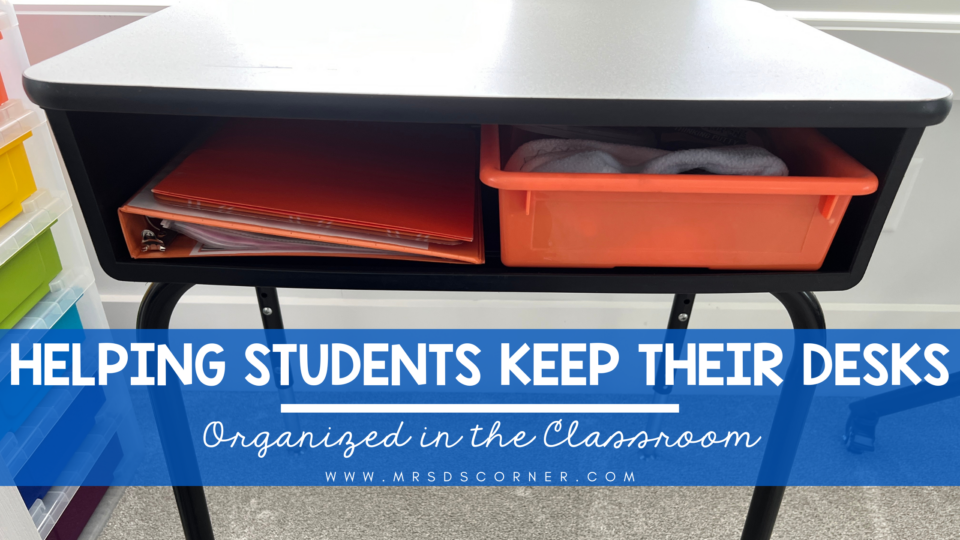Organization doesn’t come naturally for most students, and that means that we, as teachers, need to teach our students how to get and stay organized in the classroom.


The good news? It’s easier than you may think. The bad news? It takes a lot of modeling, and for some students, it may take a long time to master – if they ever master it!
As a teacher, you may often find yourself struggling to help your students keep their desks and other belongings organized. It’s a common challenge, but with a few simple steps, you can make a big difference in promoting tidiness and efficiency among students. Just be prepared to do a lot of modeling and reminding, and have a lot of patience as you help your students become master organizers!
This post contains affiliate links to items that might help you when you’re teaching.
Step 1: Organize Inside the Student’s Desk
The first step in helping students keep their desks organized is to work with them to declutter and arrange the items inside. Start by removing everything from the desk and sorting through the items together. Encourage the student to only keep the essentials and to discard or store away any unnecessary items.
This can be a challenging and painful step for your students who love to hold on to everything. If it’s something that they don’t need to keep in their desk, but they don’t want to throw it away, suggest that they take it home and share it with their family.
Step 2: Everything In Its Place
Next, designate specific areas within the desk for different types of items. You may have heard the saying, “A place for everything and everything in its place.” That’s the concept you want to promote with your students as they start to tackle organizing their desks.
Not sure how to designate different areas? Here are some ideas: one section can be for books, another for notebooks, and a separate section for stationery supplies like pencils, markers, pens, and erasers. Use containers or dividers to help keep everything in its place.
Here are some of our favorite desk organizers that you can suggest to students or have parents provide for them at the beginning of the school year.
- Accessories Organizers – these are great for pens, pencils, markers, scissors, and glue sticks
- Larger Organizer – I also really like these because they have solid, hard sides and a lip that makes them easy to slide out of the desk.
- Pencil Holder – These little pencil grip holders are so helpful for sticking to the side of the desk or right inside. You can even stick them on the top of the inside of the desk, so they’re out of the way.
- Desk Dividers—These dividers can also come in handy if you want to divide areas of students’ desks for books.
I do recommend staying away from cardboard bins or dividers because they just don’t stand up to what students put them through throughout the school year.
Step 3: Take a Picture of the Organized Desk
Once the desk is neatly organized, take a picture of it. This visual representation will serve as a helpful reference point for the student to remember how their desk should look when it’s tidy and organized.
Step 4: Print it Out and Give it to the Student
Print out the picture of the organized desk and give it to the student to keep either taped to the side of their desk or taped right inside of it. Encourage them to refer to the picture regularly as a guide for maintaining order in their desks. This visual cue can be a very powerful tool in reinforcing good organizational habits.
When you want students to tidy their desks, you can simply say, “Check your picture!” In this instance, a picture truly is worth a thousand words!
Step 5: Extend the Organization
In addition to desks, you can apply similar organizing techniques to other areas where students store their belongings. Whether it’s lockers, cubbies, backpacks, lunch boxes, or pencil boxes, the same principles of decluttering, sorting, and designating specific spaces can help keep these areas neat and functional.
By taking the time to help students organize their personal spaces and providing visual cues for reference, you can empower them to take ownership of their belongings and cultivate a sense of responsibility toward maintaining orderliness in the classroom and with their own space.
Remember, establishing good organizational habits early on can have a lasting impact on a student’s academic performance and overall well-being. So, roll up your sleeves, grab some containers, and start organizing – you’ll be amazed at the positive difference it can make in your classroom and your students’ lives!

